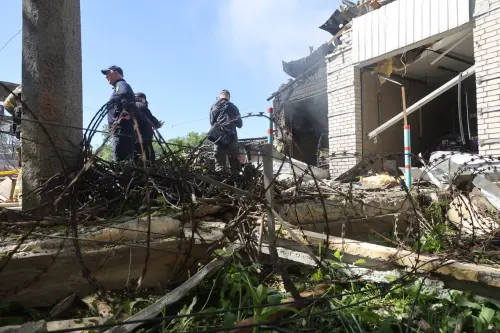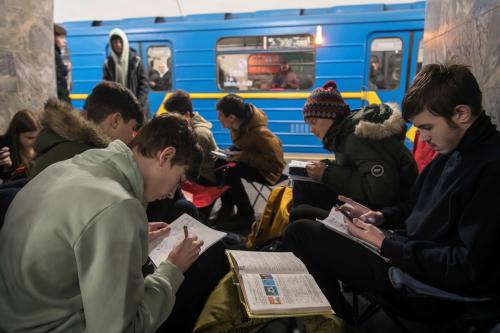Content from the Brookings Doha Center is now archived. In September 2021, after 14 years of impactful partnership, Brookings and the Brookings Doha Center announced that they were ending their affiliation. The Brookings Doha Center is now the Middle East Council on Global Affairs, a separate public policy institution based in Qatar.
John Kerry’s visit to Sri Lanka, the first by a secretary of state in 11 years, recognizes the country’s geopolitical importance. It also highlights the outcome of the recent tussle over the island state by two emerging global powers, a contest in which India has gained the upper hand over China. The struggle provides important lessons for rising powers as they begin a ‘Great Game’ in Asia.
Sri Lanka sits at the heart of the Indian Ocean, adjacent to major shipping routes, within the world’s most dynamic region—the Indo-Pacific. Long described as the ‘pearl of the Indian Ocean,’ Sri Lanka was, up until the January election defeat of President Mahinda Rajapaksa, drifting out of India’s orbit and increasingly seen as part of China’s ‘string of pearls.’ But while growing economic links correlating with China’s rise change little regardless of who is president of Sri Lanka, politically, Indian Prime Minister Narendra Modi’s government was able to snatch back this pearl from Beijing’s string.
While Sri Lanka’s people voted out a government that happened to be Beijing-friendly, it wasn’t foregone that its successor should be this pro-New Delhi. And though it does not prove whether Delhi or Beijing is the more astute strategist, and while acknowledging India’s inherent geographical advantages regarding Sri Lanka, the Modi government’s deft diplomacy provides important lessons. These are the same lessons that a century ago, a rising United States learnt from existing superpower Britain. This includes the importance of sharpening the two main foreign policy tools—insight and influence. This is relevant for Beijing: that its ‘tried and true’ blunt instruments of the trade/investment carrot and the military force stick, cannot succeed alone.
Colombo’s backslide toward Delhi began during Sri Lanka’s 2014 election campaign. The opposition used allegedly corrupt deals made between Rajapaksa and Beijing as a campaign tool. This already suggests a public relations defeat for the People’s Republic.
Following its election win, the new Sri Lankan government touted the strengthening of ties with India, and made little effort to conceal the shift away from China.
This is a particularly acute failure for China given that Beijing had a powerful story it could have told the Sri Lankan public. Namely, that China was there when no one else was. The civil war between Sri Lanka’s government and Tamil Tiger rebels was Asia’s longest. Governments came and went. The pivotal factor in Colombo’s ultimate victory over the Tamil Tigers was not domestic (though the 2005 tsunami played a role). It was external: the rise of China.
Even hawkish Sri Lankan governments had been hamstrung in pursuing a definitive victory against the Tigers, due to fear of upsetting the West, which insisted upon adherence to human rights and international law in the conduct of war. If not, trade and aid levers might be pulled, harming Sri Lanka’s economy and a government’s chance of re-election.
When China emerged as a major economic power willing and able to step into any void left by the West, it allowed Rajapaksa freedom in prosecuting the war. Beijing provided lethal military equipment and post-war diplomatic support that Delhi wouldn’t. The ending of the war remains a major issue in the national psyche, and for the majority of Sri Lankans, Rajapaksa’s greatest achievement.
In contrast, India’s reputation in Sri Lanka regarding the war ranges from mixed to negative: from Tamils with painful memories of Indian peacekeepers fighting the Tigers, to Sinhalese who blame India for training the Tigers and then preventing their defeat in 1987.
How then, did India attain a better image than China? It may be partly due to Delhi’s cultural diplomacy, underpinned by ‘in-country insight.’ During Modi’s visit, he garnered favor with Sri Lanka’s Sinhalese majority by visiting and worshipping at Buddhist holy sites. This continued the ‘Buddhism diplomacy’ employed in his ‘act East’ approach, reaching out to Buddhist neighbors.
Emphasizing India’s Buddhist history and positioning himself as a representative of ‘all of Indian culture’ is not unexpected from this devoutly Hindu prime minister. The Hindutva movement, from which Modi arose, has long described themselves as the vanguard of all what they consider Indian heritage.
Modi also visited the island’s Tamil cultural heartland. Showing his commitment to Tamil welfare helped him to endear himself to both Sri Lankan and Indian Tamils. Knowing that Sri Lankans often suspect that India’s Tamil-Nadu state controls Delhi’s Sri Lanka policy, Modi has tried to claw back policy control and reclaim the narrative; highlighting that ancient Indo-Lankan ties stretch deeper than the war.
If China is to influence smaller states, it needs to develop deep insight of these states within its foreign policy institutions. In Sri Lanka, Beijing also could have tapped into Buddhism. It could have considered the analyses of ancient India’s Machiavelli, Kautilya, which seem to have played out in modern South Asia.
China should have known Sri Lanka’s history of civil society and the risks of pursuing deals perceived as corrupt. Beijing could have helped Rajapaksa emphasize that China invested in projects which India declined, and promote investments which are visible to ordinary Sri Lankans, like infrastructure.
Delhi’s ability to attract Colombo was also due to its ability to influence. Rajapaksa has claimed that India’s spy agency helped organize opposition groups before the election. Delhi denies this. True or not, India seems to have trumped China in cultivating stronger ties with key power nodes within Sri Lankan society. Beijing could have used investments to strengthen links with the business elite. It could have supported rural nationalists in leveraging suspicion of India to paint the Opposition as ‘traitors’—a tag which was pivotal in earlier opposition defeats.
Both tools—insight and influence—require tapping into a diverse domestic foreign policy community across government departments, think-tanks and universities. To take full advantage, Delhi and Beijing must use the best advice the pool provides, not just advice from those most loyal. The sharpest evidence-based analyses and predictive capabilities should be rewarded. The fact that such a meritocracy was utilized more by the only remaining superpower than its now vanquished opponent should be something rising powers take note of.



Commentary
India v. China in Sri Lanka—Lessons for rising powers
May 1, 2015